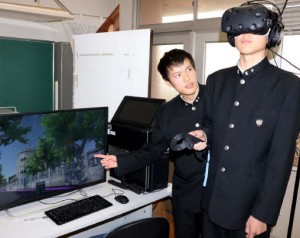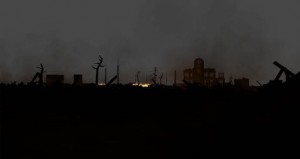Fukuyama Technical High School’s virtual reality video of A-bomb day is viewed in U.S.
Oct. 25, 2017
by Tomoko Takamoto, Staff Writer
On October 25 and 26, the virtual reality (VR) video created by the computation skill research club at Fukuyama Technical High School, located in Fukuyama, Hiroshima Prefecture, will be made available to the public at Syracuse University in the U.S. state of New York. This VR video has reproduced the area near the hypocenter in Hiroshima before and after the atomic bombing. VR technology can overcome language barriers by highlighting the horrific consequences of the atomic bombing with images and sound. Students from the school hope that their work can move people in the nuclear weapons state to feel the horror of nuclear weapons first-hand and consider this issue more deeply.
The five-minute VR video reproduces the area within 300 meters of the hypocenter. After putting on the goggle-type headset, you can first see the image of the area before the atomic bombing occurred. With the controller, you can even “walk through” the virtual area of shops and trees. Then ahead there is a flash of light and the sound of the bomb blast and the scene changes to images of flames and black smoke, with the dead lying on the ground.
The VR work has been lent to an atomic bomb exhibition being held at the university. An A-bomb survivor will also attend the event to recount an experience of the bombing. The video will be on loan to the university until December. Tsubasa Hirata, 18, the president of the club, said firmly, “I would like people to know what would happen if only one of the nuclear weapons held by their nation is used.”
When a professor from the university learned about the high school’s VR work during a visit to Japan, that person proposed making use of it in the United States. However, after the professor watched the VR video, prior to the exhibition, the reaction shared with the school was “The images of and after the atomic bombing are shocking. Wouldn’t it be possible to use only the first part of the video, before the bombing?” Katsushi Hasegawa, the advisor for the club, then told the professor that it would be best for people to virtually experience both before and after the atomic bombing in order to understand the horror of losing everything through a nuclear attack.
Reactions from users of the VR work will be provided afterwards. Yuhi Nakagawa, 17, a second-year student at the school, said, “This shows that our efforts are having an impact. I hope our video can be experienced by as many people as possible.”
Keywords
Virtual reality (VR) technology
Computer-made technology that creates a simulated experience of reality with virtual images and sound. The technology can create a 360-degree virtual space by using a goggle-type display, thus stimulating the wearer’s senses of sight and hearing.
(Originally published on October 25, 2017)
On October 25 and 26, the virtual reality (VR) video created by the computation skill research club at Fukuyama Technical High School, located in Fukuyama, Hiroshima Prefecture, will be made available to the public at Syracuse University in the U.S. state of New York. This VR video has reproduced the area near the hypocenter in Hiroshima before and after the atomic bombing. VR technology can overcome language barriers by highlighting the horrific consequences of the atomic bombing with images and sound. Students from the school hope that their work can move people in the nuclear weapons state to feel the horror of nuclear weapons first-hand and consider this issue more deeply.
The five-minute VR video reproduces the area within 300 meters of the hypocenter. After putting on the goggle-type headset, you can first see the image of the area before the atomic bombing occurred. With the controller, you can even “walk through” the virtual area of shops and trees. Then ahead there is a flash of light and the sound of the bomb blast and the scene changes to images of flames and black smoke, with the dead lying on the ground.
The VR work has been lent to an atomic bomb exhibition being held at the university. An A-bomb survivor will also attend the event to recount an experience of the bombing. The video will be on loan to the university until December. Tsubasa Hirata, 18, the president of the club, said firmly, “I would like people to know what would happen if only one of the nuclear weapons held by their nation is used.”
When a professor from the university learned about the high school’s VR work during a visit to Japan, that person proposed making use of it in the United States. However, after the professor watched the VR video, prior to the exhibition, the reaction shared with the school was “The images of and after the atomic bombing are shocking. Wouldn’t it be possible to use only the first part of the video, before the bombing?” Katsushi Hasegawa, the advisor for the club, then told the professor that it would be best for people to virtually experience both before and after the atomic bombing in order to understand the horror of losing everything through a nuclear attack.
Reactions from users of the VR work will be provided afterwards. Yuhi Nakagawa, 17, a second-year student at the school, said, “This shows that our efforts are having an impact. I hope our video can be experienced by as many people as possible.”
Keywords
Virtual reality (VR) technology
Computer-made technology that creates a simulated experience of reality with virtual images and sound. The technology can create a 360-degree virtual space by using a goggle-type display, thus stimulating the wearer’s senses of sight and hearing.
(Originally published on October 25, 2017)









